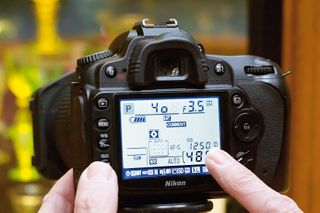Use a polarizing filter to cut through reflections
Polarizing filters do more than just darken blue skies – you can also use them to cut through reflections
Watch the video: Use a polarizing filter to cut through reflections
Polarizing filters are often used to enhance blue skies, but this is only one of their uses. The light reflected from smooth and glossy surfaces is ‘polarized’, too, and you can use a filter to cut through these reflections to show what’s beneath. This is really useful if you need to shoot objects that are displayed behind glass, so we visited the Victoria Art Gallery in Bath to try this out.
Polarizing filters come in different types, and it’s important to get the right one. You can get older, simpler, ‘linear’ polarizers, but while these were fine with film cameras, they’re not suitable for digital cameras because they interfere with the autofocus systems. Instead, you will need a newer (and more expensive) ‘circular’ polarizer. These have the same effect, but use a more complex optical design to prevent autofocus issues.
• 10 things you need to know about camera filters!
There are a few things to watch out for when using polarizers. The image in the viewfinder will be darker, for a start, making it more difficult to judge the focus manually. Stick to autofocus, set the camera to single-point AF mode, and use the multi-selector to choose the best focus point within the scene.
Make sure that the camera isn’t focusing on the reflection in the glass rather than the object behind it, too. Your best chance of avoiding this is to make sure that you set the focus when the polarizing effect is strongest, not while you can see glare on the glass.
You will find that there are some reflections that are just too strong to get rid of completely, like bright light sources or patterns of sunlight and shade. The one thing you won’t be able to eradicate is reflections in mirrors. Polarizers are only effective on light glancing off surfaces at an angle. However, follow our advice and you’ll find that avoiding other reflections when taking photos is a piece of cake.

01 Use a tripod

Polarizers cut down the light entering the lens by up to two stops. If shooting indoors the light levels will already be low, so exposure times will make handheld photography difficult. Using a tripod enables you to adjust the angle of the polarizer precisely, without the risk of moving the camera.
02 Find the angle

Turn the polarizing filter while watching the image in the viewfinder. You’ll see the reflections in the glass grow fainter and then disappear altogether. Tiny adjustments make all the difference, and it’s worth taking a few moments to check that you’ve found the optimum angle of rotation.
03 Move further away

If you can’t get rid of all the reflections, you may be too close while using a wide zoom setting. The reflections will be coming from a range of angles, and the filter won’t be able to counteract them all. Move further away and use a longer zoom setting so that the reflections are easier to subdue.
04 Shooting handheld

If you can’t use a tripod, increase the ISO to prevent camera shake. Your camera's Auto ISO function is best for this, as it will set the ISO automatically for each shot to achieve a minimum shutter speed. We’ve chosen a speed of 1/40 sec here, and the camera has set the ISO to 1250 to enable this.

Photography tips: 5 pointers for polarizing filters

01 Mind your feet
You can get reflections when you shoot downward through glass. Here the polarizer has cut through the reflection of the floor (polarizer has been used on the left half of the image, no polarizer on the right).

02 Shop windows
You can snap some great shots through shop windows if you use a polarizing filter to cut through the glare (polarizer has been used on the left half of the image, no polarizer on the right).

03 Blue-sky thinking
Polarizing filters are great for making skies bluer, but watch out if you’re using a wide angle as the effect is uneven.

04 Richer foliage
The glossy surface of leaves reflects light. A polarizer cuts through the sheen and delivers rich greens in your landscapes.

05 Slow down
A polarizer’s 2-3EV light decrease helps you blur moving water to create a stronger sense of movement.

More videos:
The best polarizing filters in 2019
How to use polarizing filters for colorful cross-polarization effects
Infrared photography using a filter: tips and techniques
How to use an ND filter for slow-shutter-speed seascapes
Get the Digital Camera World Newsletter
The best camera deals, reviews, product advice, and unmissable photography news, direct to your inbox!

Rod is an independent photography journalist and editor, and a long-standing Digital Camera World contributor, having previously worked as DCW's Group Reviews editor. Before that he has been technique editor on N-Photo, Head of Testing for the photography division and Camera Channel editor on TechRadar, as well as contributing to many other publications. He has been writing about photography technique, photo editing and digital cameras since they first appeared, and before that began his career writing about film photography. He has used and reviewed practically every interchangeable lens camera launched in the past 20 years, from entry-level DSLRs to medium format cameras, together with lenses, tripods, gimbals, light meters, camera bags and more. Rod has his own camera gear blog at fotovolo.com but also writes about photo-editing applications and techniques at lifeafterphotoshop.com